

Uncovering the Links Between the Brussels and Paris Attackers. Key links between the attacks Key links between the attacks established through fingerprints or DNA evidence One of the key connections between the two groups is Najim Laacharoui, the second suicide bomber at the Brussels airport, who made bombs used in both the Brussels and Paris attacks.
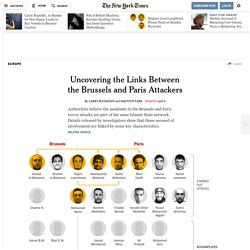
Another connection between the two groups is Mohamed Abrini, 30. Officials said Mr. Lived in Brussels At least 14 individuals tied to both attacks were either Belgian or lived in Brussels. Committed Previous Crimes Many of the identified assailants in both plots had criminal backgrounds. Visited or Tried to Enter Syria. Foreign Fighters In Iraq And Syria. Pietervanostaeyen « Musings on Arabism, Islamicism, History and current affairs.
Foreign Fighters In Iraq And Syria. La carte des sites de la Mésopotamie antique en péril. Ces chefs-d'oeuvre du patrimoine archéologique mondial menacés par l’Etat islamique. Détruits menacés La fureur des terroristes de l’Etat islamique passe aussi par la purification culturelle.
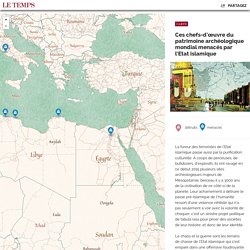
A coups de perceuses, de bulldozers, d’explosifs, ils ont ravagé en ce début 2015 plusieurs sites archéologiques majeurs de Mésopotamie, berceau il y a 3000 ans de la civilisation de ce côté-ci de la planète. Leur acharnement à détruire le passé pré-islamique de l’humanité ressort d’une violence nihiliste qui n’a pas seulement à voir avec la volonté de choquer, c’est un sinistre projet politique de tabula rasa pour priver des sociétés de leur histoire, et donc de leur identité. Le chaos et la guerre sont les terrains de chasse de l’Etat islamique qui s’est emparé dans une offensive foudroyante du nord de l’Irak à l’été 2014, contrôle une partie de la Syrie et étend ses filets jusqu’en Libye.
Sur le même sujet lire aussi: Etat islamique. How ISIS Works. Organization The Islamic State in Iraq and Syria has a detailed structure that encompasses many functions and jurisdictions, according to ISIS documents seized by Iraqi forces and seen by American officials and Hashim Alhashimi, an Iraqi researcher.
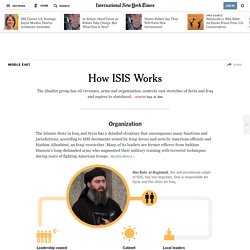
Many of its leaders are former officers from Saddam Hussein’s long-disbanded army who augmented their military training with terrorist techniques during years of fighting American troops. Related article » Abu Bakr al-Baghdadi, the self-proclaimed caliph of ISIS, has two deputies. One is responsible for Syria and the other for Iraq. Leadership council Mr. Cabinet Managers oversee departments like finance, security, media, prisoners and recruitment. Local leaders At least a dozen deputies across Iraq and Syria report to the deputy of each country. Sources: Jasmine Opperman, Terrorism Research & Analysis Consortium; Hisham Alhashimi. Territory ISIS-controlled places Areas under full control Areas of recurring attacks Sparsely populated areas Financing. Tracking the Islamic State's rise - Washington Post. A Rogue State Along Two Rivers.
Aleppo: Ejected by Other Rebel Groups In 2013, ISIS emerged from the remnants of Al Qaeda in Iraq and began to operate in Syria.

The vacuum created by the country’s civil war provided a place for ISIS to rebuild. Syrian rebel groups initially welcomed ISIS as an ally, but soon realized that they did not have the same goals. ISIS was more interested in forming an Islamic state than in toppling the Syrian government — and had no problem with killing other insurgents to make it happen.
These tensions culminated in a revolt against ISIS. Jarablous: Supply Routes ISIS Control After being pushed out of Aleppo, ISIS moved east, attacking rebel bases and taking over towns like this one, near the border with Turkey, that are arteries for money and supplies. Raqqa: Instituting Strict Rules Via Associated Press In keeping with its goal of creating an Islamic state, ISIS has instituted strict rules in most of the towns it has seized. Deir al-Zour: Besieging a Provincial Capital. Areas Under ISIS Control. Control: Iraqi Security Forces Contested Previously contested area The last ISIS fighters left the government buildings on Dec. 28.
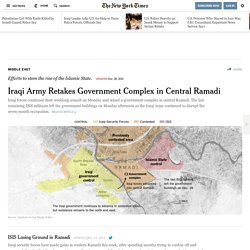
Iraqi forces advanced into central Ramadi. The Fates of 23 ISIS Hostages in Syria - NYTimes.com. 40 Maps That Explain The Middle East. Maps can be a powerful tool for understanding the world, particularly the Middle East, a place in many ways shaped by changing political borders and demographics.
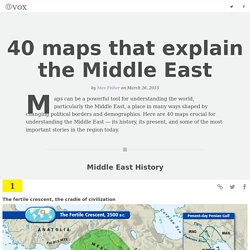
Here are 40 maps crucial for understanding the Middle East — its history, its present, and some of the most important stories in the region today. Middle East History The fertile crescent, the cradle of civilization The fertile crescent, the cradle of civilizationIf this area wasn't the birthplace of human civilization, it was at least a birthplace of human civilization. Called "the fertile crescent" because of its lush soil, the "crescent" of land mostly includes modern-day Iraq, Syria, Jordan, and Israel-Palestine. (Some definitions also include the Nile River valley in Egypt.)
The Middle East today The dialects of Arabic today The dialects of Arabic todayThis map shows the vast extent of the Arabic-speaking world and the linguistic diversity within it. Israel-Palestine Syria Iran Afghanistan Saudi Arabia and Oil Iraq and Libya.